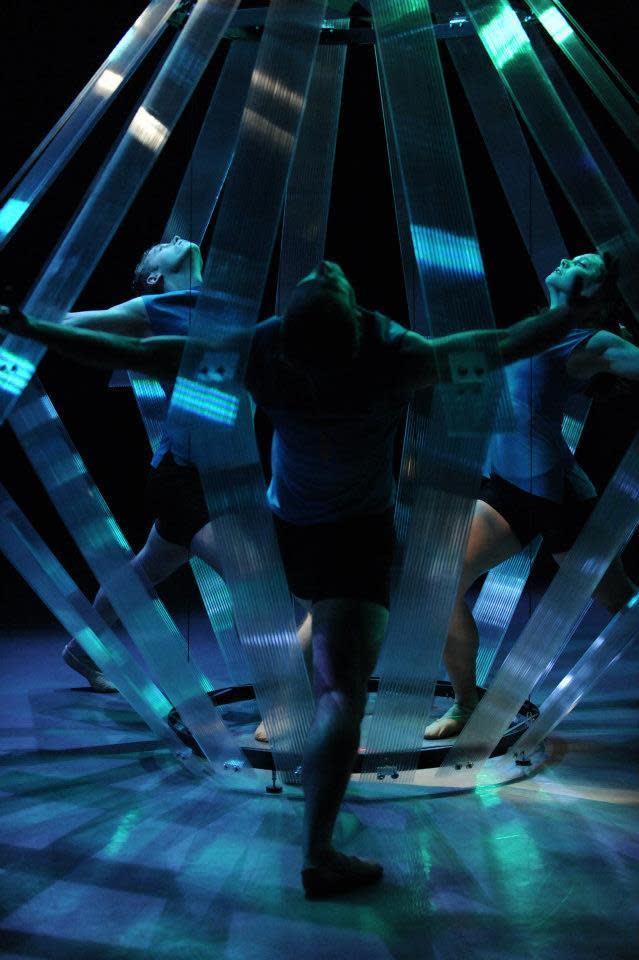Review: skinner|kirk Dance Ensemble

Photo by David Krebs
The brothers Ribner, playing everything from piano to horn to accordian to drums, wove one of the most dynamic and integrated dance scores in recent memory as they ventured deep into the realm of trip hop and avant garde. Tim, who collaborates regularly with choreographer Josie Moseley for her dance classes, seemed to viscerally intuit the dancers’ movements, guiding and playing off them with seamless harmonic beauty. At times, he was more seductive to watch than the dance itself, diving into the guts of his open baby grand piano, pounding and sliding along the strings with a playful inventiveness I’ve only seen Herbie Hancock do.
But whereas the trippy, industrial nature of the music and sculpture desired angular, edgy contemporary dance, the choreography itself was almost completely, flowingly modern, and thereby somewhat bland in comparison. Which isn’t to say there weren’t wonderful moments, particularly the duet between Skinner and Brennan Boyer, a former Oregon Ballet Theatre soloist and the only non-BodyVox member in the ensemble, whose graceful form shined throughout the night. But the only moments in which the dance really jived with the set and sound was the solo work of Holly Shaw, who twirled with clenched fists and liquid movement that recalled the warehouses in which one might hear the electronica of Tobin.
More than juxtaposition, the choreography spoke to me of transgression of boundaries. Instead of simply dancing inside or out of the sculptures, the dancers defied our expectations, constantly stepping in and out of the barrels, penetrating the gaps between slats with arms and legs. It was an exciting decision, one that made better use of the structures than OBT’s heartbreaking underutilization of John Grade’s sculptures in the recent Body Beautiful performance. But it also resulted in a level of awkwardness, as the dancers visibly worked to avoid hitting the slats.
The second piece of the evening, Suspended in Mid-Air (and about to collapse), originally performed in 2002, seemed almost more deserving of the name Juxtaposition, being a collage of things linked to Russian Constructivism: ballet (the industrial machine of dance), propaganda poster poses, classical music, Nina Hagen, more Amon Tobin, white outfits with primary color blocks like they were designed by Piet Mondrian, etc. It was a better showcase of the dancers’ balletic training (Skinner, Kirk, Boyer, and Zachary Carroll each spent years with OBT), and as such they danced more tightly as a full ensemble. And like the first piece, it too had beautiful moments of exquisite dance, particularly its series of group lifts to choral music that exalted the individual bodies for the glory of all mankind. But with two exceptions—a sequence set to the industrial electronica of Tobin where the dancers tossed their limbs like rag dolls being jerked by violent children and an impressive acrobalance sequence where Kirk was visibly shaking as he supported Skinner in precarious positions—the piece never much descended into the “chaotic moments” that the program explains will deconstruct the Constructivist structure and signal the edge of collapse. Like Juxtaposition, I felt like the piece pulled its punches, excelling at the bright side of its equation, but not taking much risk in it’s exploration of the darker side of its contrast and collapse.
I realize it’s an odd thing to say a company’s work is too beautiful. But given the mission the artistic directors themselves set out, skinner|kirk, known for their acrobalancing and aerialist work, nailed their mid-air suspension—now they just need to work on their collapse.
Skinner|kirk Dance Ensembe performs at BodyVox through December 8. More info here.
